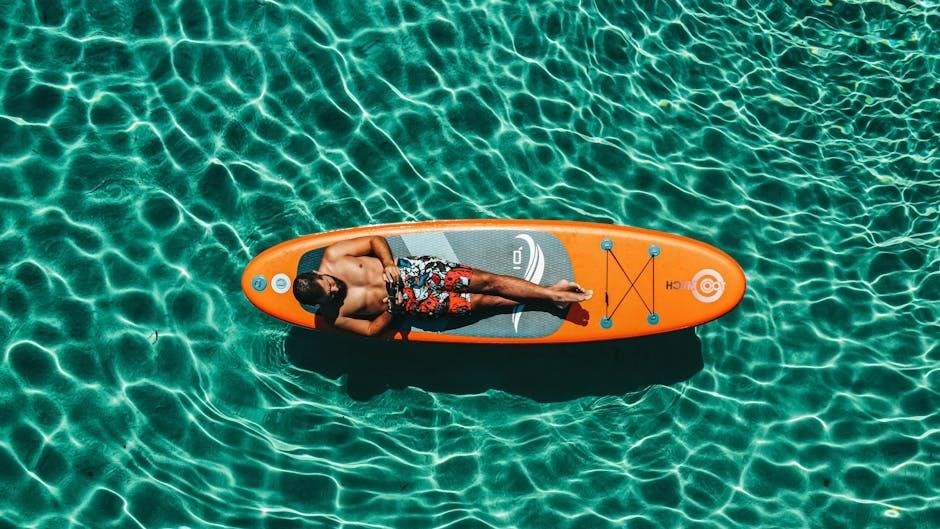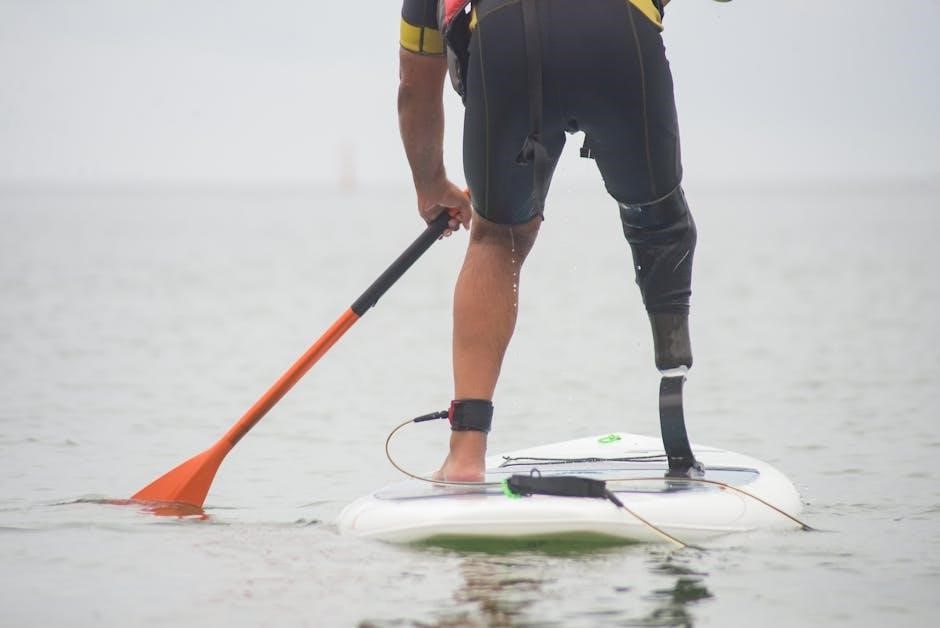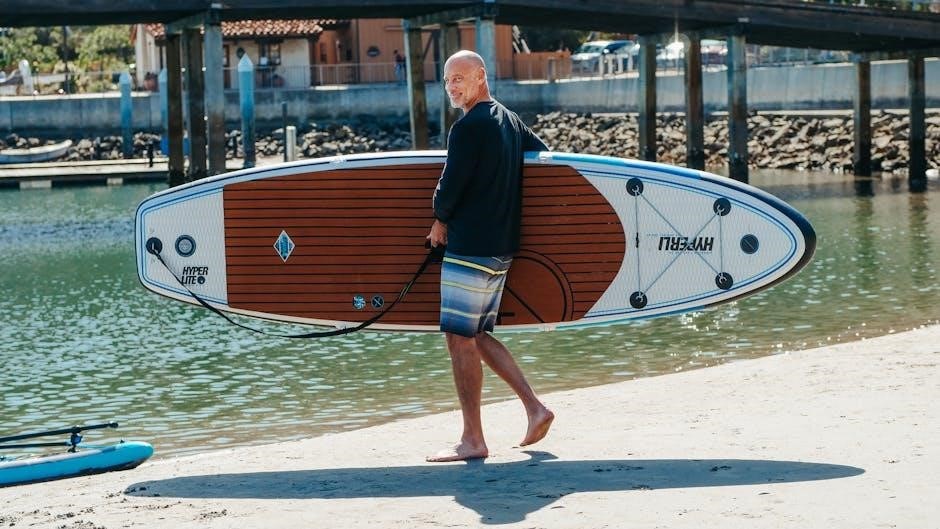Welcome to our SUP Board Size Guide! Learn how board dimensions impact performance, stability, and your overall paddling experience. This guide helps you choose the perfect SUP for your needs, whether you’re a beginner or an advanced rider.
1.1 Understanding the Importance of SUP Board Size
SUP board size is crucial for performance, stability, and maneuverability. The right size ensures proper buoyancy, making it easier to balance and paddle efficiently. A board that’s too small may lack stability, while one that’s too large can be difficult to handle. Understanding how size impacts your experience is key to enjoying stand-up paddleboarding, whether you’re cruising calm waters or tackling challenging terrain. Choosing the correct dimensions enhances your overall paddling experience and helps you progress in the sport.
1.2 Brief History and Evolution of SUP Boards
Stand-up paddleboarding traces its roots to ancient cultures, such as Polynesian and Peruvian civilizations, where paddlers used primitive boards for transportation and fishing. Modern SUP emerged in Hawaii in the 1950s as a surfing variation. Over time, board designs evolved from wooden surfboards to lightweight, durable materials like foam and fiberglass. Today, advancements in technology have led to inflatable boards and specialized designs for racing, touring, and yoga, catering to diverse paddling needs and preferences worldwide.
Key Factors Influencing SUP Board Size
Rider weight, skill level, intended use, and water conditions are crucial in determining the ideal SUP board size, ensuring optimal performance and stability for every paddling experience;
2.1 Rider Weight and Skill Level
Rider weight and skill level significantly impact SUP board size. Heavier paddlers need higher volume for buoyancy, while lighter riders can manage with less. Beginners benefit from larger, thicker boards for stability, making it easier to balance and maneuver. Advanced riders can opt for smaller, more maneuverable boards, prioritizing performance over stability. Matching the board size to individual weight and skill ensures a more enjoyable and optimal paddling experience.
2.2 Intended Use of the SUP Board
The intended use of a SUP board plays a crucial role in determining its size. Boards designed for racing are longer and narrower for speed, while touring boards offer a balance of speed and stability. Yoga and fishing require wider, more stable boards for comfort and balance. Recreational boards are versatile, catering to casual paddling. Understanding how you’ll use your SUP helps narrow down the ideal size and shape for your activities.
2.3 Water Conditions and Terrain
Water conditions and terrain significantly influence SUP board size. Calm waters, like lakes or slow-moving rivers, allow for narrower, longer boards for speed and efficiency. Rough or ocean conditions require wider, more stable boards for better control. Inflatable boards are ideal for whitewater or rocky terrains due to their durability. Flatwater paddling benefits from longer, streamlined boards, while coastal or open ocean conditions may demand added volume for stability. Matching your board size to the environment ensures a safer, more enjoyable experience.

Understanding SUP Board Dimensions
This section breaks down SUP board dimensions, including length, width, thickness, and volume. Each dimension affects performance, stability, and maneuverability, helping you choose the right board for your needs.
3.1 Length: How It Affects Performance
Length significantly impacts a SUP board’s stability, speed, and maneuverability. Longer boards (over 12 feet) enhance glide and tracking, ideal for touring or racing, while shorter boards (under 10 feet) offer agility for surfing or tight turns. A mid-length board (10-12 feet) balances stability and versatility, suitable for all-around use. Choosing the right length ensures optimal performance based on your paddling style and intended activities.
3.2 Width: Balancing Stability and Speed
Width plays a crucial role in balancing stability and speed. Wider boards (32-34 inches) provide greater stability, making them ideal for beginners, yoga, or fishing. Narrower boards (under 30 inches) sacrifice some stability for increased speed and agility, better suited for racing or touring. A medium width (30-32 inches) offers a versatile balance, catering to all-around paddling. The right width ensures comfort, ease of movement, and optimal performance based on your activity and skill level.
3.3 Thickness: Impact on Floatation and Maneuverability
Thickness significantly impacts a SUP board’s floatation and maneuverability. Thicker boards (over 5 inches) provide greater buoyancy, making them more stable and suitable for beginners or calm waters. Thinner boards (under 5 inches) are lighter, enhancing speed and agility, ideal for advanced riders in dynamic conditions. The right thickness ensures optimal performance, balancing stability, speed, and responsiveness based on your paddling style and water conditions.
3.4 Volume: The Key to Buoyancy and Stability
Volume, measured in liters, determines a SUP board’s buoyancy and stability. Higher volume boards float better, supporting heavier riders or calm water conditions, while lower volume boards excel in dynamic waters, offering greater agility. Volume is calculated by multiplying length, width, and thickness. A board with the right volume for your weight ensures proper floatation, optimizing stability and maneuverability for a superior paddling experience, whether cruising or surfing.
Choosing the Right SUP Board Size for Your Needs
Discover how to select the perfect SUP board based on your weight, skill level, and paddling goals. This guide offers tailored recommendations for every rider and activity type.
4.1 For Beginners: Stability and Ease of Use
For beginners, stability is crucial. Wider and longer boards provide better balance, making it easier to stay upright. A board with a width of 32-34 inches and a length of 10-11 feet is ideal for newcomers. These dimensions offer a stable platform, allowing you to focus on paddling technique without struggling to stay balanced. Additionally, a slightly higher volume (around 180-240 liters) enhances buoyancy, making the board more forgiving for those learning the basics of SUP.
4.2 For Advanced Riders: Speed and Agility
Advanced riders prioritize speed and agility, requiring boards tailored for performance. A narrower width (28-30 inches) and shorter length (12-14 feet) reduce drag, enabling quicker turns and faster gliding. These boards typically have lower volume (140-200 liters), allowing for precise control and maneuverability. They are ideal for experienced paddlers seeking a dynamic, responsive ride, perfect for racing or carving through waves. A smaller board size enhances efficiency, making it easier to maintain momentum and push limits in challenging conditions.
4.3 For Specific Activities: Racing, Touring, Yoga, Fishing
Different SUP activities demand specialized board sizes. Racing requires narrow, lightweight boards (12-14 feet) for speed. Touring boards (12-14 feet) are sturdy and stable for long distances. Yoga and fishing benefit from wider, more stable boards (10-12 feet) with ample space for movement or gear. Each activity’s unique needs dictate the ideal board size, ensuring optimal performance and enjoyment. Choose a board tailored to your pursuit for the best experience on the water.

4.4 Considering Your Weight and Height
Your weight and height significantly influence SUP board size. Lighter, shorter riders may prefer smaller boards for easier maneuverability, while heavier or taller individuals need larger boards for stability. Generally, boards with higher volume better support heavier riders. Ensure the board’s width and length align with your height for comfortable standing and paddling. Balancing your weight and height with the board’s dimensions ensures optimal buoyancy and control, enhancing your overall paddling experience.

Popular SUP Board Sizes and Their Uses
Discover popular SUP sizes: small boards for kids/surf, medium for all-round, large for touring/heavy riders. Inflatable options offer versatility, catering to diverse paddling needs and preferences.
5.1 Small Boards (Under 10 feet)
Small SUP boards (under 10 feet) are ideal for kids, lightweight riders, or those focusing on surfing and tight maneuvers. Their shorter length enhances agility and portability, making them easy to handle in small waves or calm waters. These boards are lightweight, easy to transport, and perfect for casual fun or advanced surfers seeking quick turns. While they may lack the stability of larger boards, they excel in dynamic conditions and are great for riders looking to improve their skills in tight spaces or fast-paced environments.
5.2 Medium Boards (10-12 feet)
Medium SUP boards (10-12 feet) are the most versatile option, balancing stability and maneuverability. They are ideal for all-around use, including calm waters, small waves, and light touring. These boards are stable enough for beginners yet responsive for intermediate riders. They are great for activities like yoga, fishing, or casual cruising. The 10-12 foot range offers a good balance between speed and ease of handling, making them a popular choice for riders seeking a well-rounded SUP experience.
5.3 Large Boards (Over 12 feet)
Large SUP boards (over 12 feet) are designed for speed and efficiency, making them ideal for long-distance touring, racing, or exploring open waters. These boards cover more water per stroke, offering excellent glide and tracking. They are highly stable, making them suitable for larger riders or those carrying gear. However, their size and weight can make them less maneuverable and harder to transport. Large boards are perfect for experienced paddlers seeking performance and endurance in calm or flat conditions;
5.4 Inflatable vs. Hard Boards: Size Differences
Inflatable SUP boards are often more compact and lightweight, making them easier to transport and store, while hard boards are typically longer and more rigid for better speed. Inflatable boards may be slightly shorter or wider for stability, while hard boards prioritize efficiency. Inflatables are ideal for travelers or those with limited space, whereas hard boards are preferred by serious paddlers seeking performance. The choice depends on your priorities: portability or speed.

Measuring and Testing SUP Board Size

Properly measuring a SUP board involves checking its length, width, and thickness. Testing it on water ensures it feels right and performs as expected for your needs.
6.1 How to Measure a SUP Board

To measure a SUP board, start by determining its length from the nose to the tail. Next, measure the width at the board’s widest point, typically across the middle. Thickness is measured from the top deck to the bottom hull. Use a tape measure for accuracy. Note that volume, which affects buoyancy, is calculated using these dimensions. Ensure measurements are precise for the best performance and fit for your needs.
6.2 Testing a SUP Board Before Purchase
Testing a SUP board before purchase is crucial to ensure it meets your needs. Check the board’s stability by standing on it in calm water. Assess how it glides and turns by paddling a short distance. Evaluate its maneuverability and responsiveness. Consider comfort and fit, ensuring it suits your height and weight. Test it in various water conditions to gauge performance. This hands-on approach helps confirm the board’s suitability for your skill level and intended use, ensuring a confident purchase decision.

6.3 Understanding Board Volume and Your Weight
Board volume plays a critical role in determining how well a SUP board supports your weight. A higher volume board offers greater buoyancy, ideal for heavier riders or those seeking stability. Conversely, lower volume boards are more maneuverable but may sink under excess weight. Ensuring the board’s volume aligns with your weight ensures proper flotation and performance. A mismatch can lead to poor stability or reduced efficiency. Always consider your weight and the board’s volume for an optimal paddling experience.
Common Mistakes in Selecting SUP Board Size
Common mistakes include choosing a board too small or too large, ignoring volume, and not considering intended use, leading to poor performance and stability issues.
7.1 Choosing a Board Too Small or Too Large
Choosing a SUP board that’s too small or too large is a common mistake. A board too small may lack stability and buoyancy, especially for heavier riders, while a board too large can be difficult to maneuver, particularly in calm waters. Riders often overlook volume, which is critical for performance. A board too small won’t track well, while an overly large one may feel cumbersome. Always consider your weight, skill level, and intended use to avoid these pitfalls and ensure optimal performance.
7.2 Ignoring the Importance of Volume
Ignoring the importance of volume is a significant mistake when selecting a SUP board. Volume directly impacts buoyancy and stability, ensuring the board can support your weight. A board with insufficient volume may feel unstable or even sink, while excessive volume can hinder maneuverability. Riders often overlook volume calculations, leading to poor performance. Always consider your weight and the board’s volume to ensure optimal stability and control, whether you’re cruising or performing advanced maneuvers.
7.3 Not Considering the Intended Use
Not considering the intended use of your SUP board is a common mistake. Different activities, such as racing, touring, yoga, or fishing, require specific board sizes and shapes. Ignoring this can lead to poor performance or discomfort. For example, a board designed for racing may lack the stability needed for yoga, while a fishing SUP may be too bulky for swift maneuvering. Always match your board’s size and design to your primary use to ensure the best experience on the water.

Advanced Tips for Optimizing SUP Board Size
Explore fine-tuning your SUP board for enhanced performance, adjust your paddling technique for optimal control, and customize your board to meet specific needs and preferences.
8.1 Fine-Tuning Your Board for Performance
Fine-tuning your SUP board involves adjusting its setup to maximize efficiency. Consider experimenting with fin configurations to improve tracking and stability. Leash placement and deck pad customization can also enhance control. Additionally, balancing weight distribution ensures optimal buoyancy. For advanced riders, modifying the board’s thickness or volume through accessories like added buoyancy aids can refine performance. Regular maintenance, such as cleaning and inspecting the board, further ensures peak functionality. These adjustments allow for a more tailored and responsive paddling experience.
8.2 Adjusting Your Technique for Different Sizes
Adapting your paddling technique to your board’s size is crucial for optimal performance. Smaller boards require more precise balance and quicker reflexes, while larger boards benefit from a more powerful stroke. Adjust your stance width and weight distribution based on the board’s length and width. Experiment with paddle angle and rhythm to maintain efficiency. Practice turning techniques suited to your board’s responsiveness. Fine-tuning your approach ensures a smoother, more enjoyable experience on the water, regardless of the board size.
8.3 Customizing Your Board for Specific Needs
Customizing your SUP board for specific activities enhances performance and enjoyment. For racing, consider a longer, narrower board for speed, while yoga benefits from a wider, more stable design. Fishing may require additional storage and mounts for gear. Adjustments can include modifying the fin setup for better tracking or adding padding for comfort. Experiment with different accessories and configurations to tailor your board to your primary use, ensuring it meets your unique demands and preferences for optimal results on the water.
Selecting the right SUP board size is crucial for optimal performance and enjoyment. Consider your weight, skill level, and intended use to make an informed decision. Test different boards, seek expert advice, and remember, the right size ensures stability, maneuverability, and fun on the water. Happy paddling!
9.1 Summary of Key Considerations
When choosing a SUP board, prioritize factors like rider weight, skill level, and intended use. Board dimensions such as length, width, and thickness play a crucial role in stability and performance. Volume ensures buoyancy, while size affects maneuverability. Consider water conditions and specific activities like racing or yoga. Testing boards before purchase is essential. Balancing these elements ensures a tailored fit, enhancing your paddling experience and overall enjoyment on the water.
9.2 Encouragement to Test and Explore

Don’t hesitate to test different SUP boards to find your perfect match. Exploring various sizes and styles helps you understand how they perform in different conditions. This hands-on approach ensures you make an informed decision. Remember, there’s no one-size-fits-all solution—every rider is unique. Embrace the process, and don’t settle until you find the board that enhances your paddling experience. The right fit will make every outing more enjoyable and keep you excited to hit the water!

